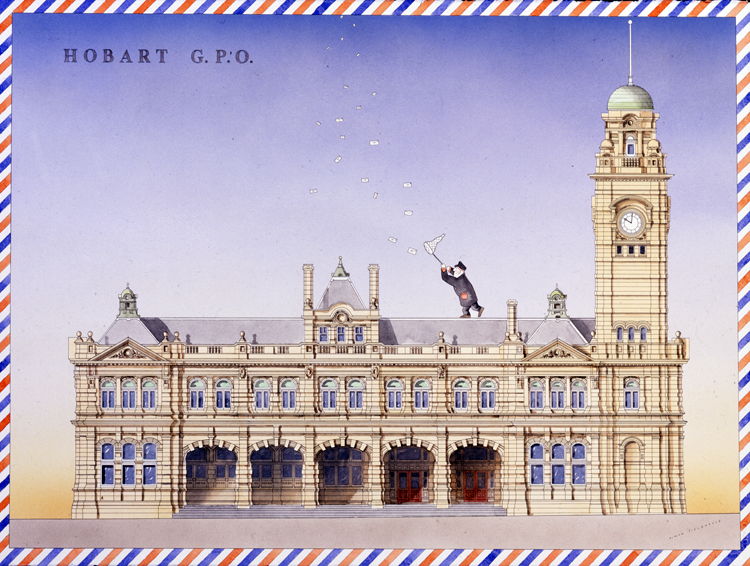
The General Post Office in Hobart
The General Post Office in Hobart, Tasmania, stands as a historic and iconic symbol of the city's communication and postal services. This magnificent structure has played a pivotal role in the city's development, serving as a central hub for mail distribution, telecommunications, and a meeting place for generations of Tasmanians.
Constructed in the mid-19th century, the General Post Office (GPO) Hobart is a testament to the architectural beauty of the era. Designed by renowned architect John Lee Archer, the building showcases a blend of neoclassical and Palladian architectural styles. Its grand façade, featuring impressive columns and intricate stonework, creates a striking presence in the heart of Hobart. The GPO's stunning architecture remains a popular subject for photographers and artists and adds to the city's historical charm.
Functionally, the GPO has been a vital institution for the city and the region. It has served as the primary hub for postal services, providing a central location for sending and receiving mail. In an age before email and digital communication, the GPO was the lifeline of personal and business correspondence, connecting Hobart to the rest of the world.
Beyond postal services, the GPO played a critical role in the development of telecommunications in Tasmania. It became a hub for telegraphy services, facilitating rapid communication across long distances. The GPO's telegraph office linked Hobart to other major cities in Australia and even to international destinations. This technological advancement helped Tasmania stay connected and updated with the latest news and developments worldwide.
Moreover, the GPO served as a social center and gathering place for the community. Locals and visitors often frequented the building for various reasons, whether to post letters, send telegrams, or simply enjoy the grandeur of the architecture. The GPO's central location made it a natural meeting point, a place where people exchanged news, caught up with friends, and conducted business.
Over the years, the General Post Office has seen many renovations and adaptations to meet the changing needs of a modern society. However, it has managed to retain its historical significance and architectural beauty. Today, it stands as a combination of historical charm and functional efficiency.
In conclusion, the General Post Office in Hobart, Tasmania, is not merely a building; it is a symbol of the city's rich history and the evolution of communication and postal services. Its architectural grandeur, functional importance, and social significance have made it an integral part of Hobart's heritage. As Hobart continues to modernize and adapt to the 21st century, the GPO remains a reminder of the city's past, a testament to the enduring importance of communication, and a beloved landmark for both locals and tourists.
The GPO's design, primarily attributed to the celebrated architect John Lee Archer, reflects the neoclassical style that was popular during the mid-19th century. The building's facade features a grand entrance framed by imposing Doric columns, which not only serve as structural support but also symbolize strength and power. The use of classical columns, a hallmark of neoclassical architecture, gives the GPO a sense of timelessness and importance.
One of the distinctive architectural elements of the GPO is its beautiful stonework. The sandstone used in its construction was quarried from nearby locations, creating a harmonious relationship between the building and its natural surroundings. The intricate detailing in the stonework, including ornate carvings and decorative elements, showcases the skill and craftsmanship of the era's artisans. These details are not merely decorative but also symbolize the values of culture and art that were esteemed during the 19th century.
Another architectural feature that stands out is the building's symmetrical design. The GPO's central entrance is flanked by balanced rows of windows and columns, creating a sense of harmony and proportion. This symmetry is a key characteristic of Palladian architecture, inspired by the work of the 16th-century Italian architect Andrea Palladio. It conveys a sense of order and balance, which was a central theme in classical architecture.
The GPO's interior is equally impressive, with high ceilings, grand archways, and detailed moldings that further accentuate the neoclassical style. The main postal hall is spacious and well-lit, with natural light streaming in through large windows, creating a welcoming and dignified atmosphere for patrons.
The clock tower of the GPO is yet another notable architectural feature. Rising above the main building, it serves both a functional and decorative purpose. The clock tower was once crucial for the synchronization of time in the city, ensuring punctuality and efficiency in the delivery of mail and communication.
Overall, the General Post Office in Hobart is a remarkable testament to the architectural prowess of the 19th century. Its neoclassical and Palladian design elements, including the grand entrance, symmetrical layout, intricate stonework, and clock tower, come together to create a building that exudes elegance, permanence, and significance. It continues to be a source of pride for the city and a symbol of the rich architectural heritage that defines Hobart's identity.